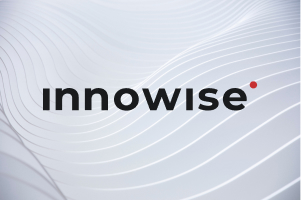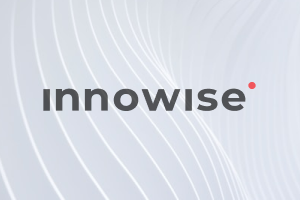Su mensaje ha sido enviado.
Procesaremos su solicitud y nos pondremos en contacto con usted lo antes posible.
El formulario se ha enviado correctamente.
Encontrará más información en su buzón.

Seleccionar idioma

Innowise tomó el producto inicial del cliente y lo reconstruyó para convertirlo en una plataforma de recarga de vehículos eléctricos sólida y de alto rendimiento. Ahora gestiona millones de sesiones y ayuda a la empresa a liderar el mercado europeo*.
exportación instantánea de los registros de las sesiones de carga
aumento del número de usuarios gracias al lanzamiento de eRoaming

Nuestro cliente es una empresa alemana que ayuda a las empresas a gestionar sus propias redes de recarga de vehículos eléctricos. Su plataforma se encarga de todo, desde la gestión de estaciones y la facturación hasta el acceso de los usuarios y el control de la energía. Admite la recarga privada y pública con herramientas para la supervisión en tiempo real, la tarificación y las conexiones de terceros. El sistema es white-label, por lo que las empresas pueden lanzarlo con su propia marca sin tener que crear la tecnología desde cero.
La información detallada sobre el cliente no puede divulgarse en virtud de las disposiciones del acuerdo de confidencialidad.
El cliente planeaba crecer en toda la UE y ofrecer a los conductores una experiencia de recarga fluida y completa. Pero la aplicación web -la principal herramienta que utilizaban los conductores- no estaba preparada para ello. Los usuarios no podían acceder a actualizaciones en directo, utilizar sus tarjetas en estaciones de terceros ni comprobar lo que estaba ocurriendo durante una sesión de recarga. Faltaban funciones como eRoaming, control inteligente de la energía y seguimiento de las sesiones, todas ellas importantes para destacar en un mercado competitivo y conseguir nuevas colaboraciones. Internamente, el frontend funcionaba bien, pero el backend y la infraestructura necesitaban mucha ayuda.
Bajo el capó, la aplicación web ya no daba abasto. No podía gestionar grandes exportaciones de datos, no tenía búsqueda en tiempo real y no admitía protocolos EV clave como OCPI u OICP. eRoaming era imprescindible, pero no había forma de incorporarlo sin revisar la arquitectura. El código base era difícil de mantener, las implantaciones eran manuales y era casi imposible hacer un seguimiento de los problemas de rendimiento. Sin un backend sólido, un pipeline DevOps o herramientas de observabilidad, la plataforma no estaba preparada para escalar.
Nuestro cliente gestiona una plataforma de movilidad eléctrica de servicio completo que combina infraestructura física con control digital inteligente. Actuando como CPO y EMSP, son propietarios de toda la experiencia de recarga, desde el hardware hasta la interfaz.
Los conductores acceden al servicio a través de aplicaciones web y móviles de marca donde pueden encontrar estaciones, iniciar sesiones de recarga y pagar. La plataforma gestiona la comunicación en tiempo real con los CPO externos mediante protocolos estándar, admite el eRoaming transfronterizo a través de Hubject y gestiona todas las relaciones comerciales en segundo plano.
El ecosistema incluye herramientas de carga inteligente y gestión de la energía para socios de infraestructuras, junto con diagnósticos, gestión de firmware y API seguras que permiten una integración perfecta con interfaces de usuario empresariales personalizadas.
La facturación se gestiona a través de un sistema flexible que admite proveedores de pago externos como Fiserv, precios basados en contratos, representación en PDF y exportaciones a Excel. Admite reglas de pago únicas para distintos socios.
Existen sistemas de notificación tanto para correos electrónicos transaccionales como para alertas en tiempo real, adaptados a los clientes empresariales. La plataforma también ofrece control de sesiones, módulos de informes y diagnósticos remotos.
Esto es más que un producto orientado al consumidor. Es una capa de control escalable que aúna infraestructura de tarificación, gestión de socios, facturación y análisis en un ecosistema cohesionado.
Empezamos por dar un paso atrás y analizar todo el sistema. ¿Qué lo frenaba? ¿Qué funciones pedían realmente los conductores y operadores? ¿Dónde fallaban las cosas cuando se disparaba el uso?
Trabajando en estrecha colaboración con los equipos de producto y de negocio del cliente, identificamos tres puntos débiles clave que necesitaban atención inmediata:
En lugar de intentar arreglarlo todo a la vez, dividimos el trabajo en fases manejables. Primero, nos centramos en hacer más estable y fiable el sistema existente. A continuación, sentamos las bases necesarias para ampliarlo: mejores API, integraciones más limpias y herramientas que el equipo de operaciones pudiera utilizar realmente en el día a día.
Una vez que comprendimos los problemas principales, dividimos el código base en módulos más pequeños e independientes para poder añadir nuevas funciones sin romper las existentes. En todo el sistema, nuestros expertos crearon una capa de caché que redujo la latencia y mejoró los tiempos de respuesta.
Para las integraciones de socios, introdujimos interfaces API estandarizadas y automatizamos grandes partes del flujo de trabajo. Lo que antes llevaba semanas de codificación personalizada, ahora requiere días de configuración. También añadimos estrictas comprobaciones de validación y errores para que los datos procedentes de las estaciones de carga siguieran siendo precisos y utilizables.
En cuanto a la infraestructura, hemos reconfigurado la plataforma para que pueda escalar horizontalmente. Ahora absorbe el tráfico pesado sin ralentizarse, lo que proporciona al cliente un sistema que crece tan rápido como su red.
Una vez sentadas las bases de la plataforma, pudimos abordar el primer gran reto: la gestión de las estaciones. La red del cliente se expandía rápidamente. Algunas estaciones eran propias, otras pertenecían a socios, pero el sistema no podía comunicarse con todas ellas de forma coherente. Lo solucionamos implementando la compatibilidad total con OCPP 1.6, el protocolo estándar del sector que utilizan la mayoría de los cargadores de vehículos eléctricos.
De este modo, el equipo de operaciones disponía de un control remoto completo de su red. Podían iniciar y detener sesiones de carga, ver lo que ocurría en tiempo real y realizar diagnósticos en cualquier estación desde un panel de control. Cuando se incorporaron nuevos socios de hardware, no hubo necesidad de recurrir a soluciones personalizadas. Basta con conectarlo, configurarlo y ya funciona.
El siguiente reto era mucho mayor: permitir a los conductores cargar en estaciones fuera de la red del cliente. Para los conductores, la recarga debería ser sencilla: se enchufa y ya está. Pero en el fondo es una maraña de contratos, protocolos e intercambios de datos entre empresas. Lo resolvimos conectándonos a Hubject, la mayor red europea de eRoaming para vehículos eléctricos. Hemos implementado tanto OCPI como OICP para gestionar la autorización entre redes, las actualizaciones en tiempo real de las estaciones y el seguimiento del uso. Esto significa que los conductores pueden utilizar estaciones de terceros directamente a través de la aplicación del cliente, sin tener que registrarse en una docena de cuentas diferentes. La empresa no necesita construir infraestructuras de recarga en todas partes, solo tiene que conectarse a las redes que ya existen a través de Hubject.
Ahora que los conductores pueden acceder a estaciones a través de múltiples redes, dirigimos nuestra atención a una preocupación creciente: la gestión de la energía. La demanda de electricidad fluctúa constantemente y nadie quiere sobrecargar la red. El cliente necesitaba una forma de ayudar a los operadores de estaciones a anticiparse a los periodos de máxima demanda.
Hemos creado un sistema de carga inteligente que permite a los operadores controlar cómo y cuándo se suministra la energía. Pueden establecer límites de uso durante las horas punta, sincronizarlo con la disponibilidad de la red o dejar que el sistema optimice automáticamente el suministro en función de las condiciones en tiempo real. Así se protege la red eléctrica, se mantienen bajos los costes de explotación y las empresas energéticas confían más en la sostenibilidad a largo plazo de la recarga de vehículos eléctricos.
También hemos añadido la tarificación por tiempo limitado para clientes corporativos, de modo que las empresas ahora pueden establecer límites de sesión como 30 minutos para que la tarificación de su flota sea justa y eficiente.
Todas estas nuevas funciones y la ampliación de las capacidades de la red suponían un aumento exponencial del flujo de datos a través del sistema. Por desgracia, el antiguo sistema de exportación no daba abasto. Era una fuente constante de frustración: todo lo que superaba los 10.000 registros se bloqueaba, dejando a los equipos con informes incompletos y horas de búsqueda manual de datos. Nuestro equipo reconstruyó el sistema de exportación desde cero. Ahora procesa conjuntos de datos de varios millones de registros con todos los detalles: ID de estación, información de usuario, tiempo de sesión, precios, etc. Todo sale en formatos listos para Excel. Todo sale en formatos listos para Excel que puedes compartir inmediatamente con tus socios financieros, legales o comerciales. Y sí, es rápido, incluso cuando se extraen datos de cuentas de gran volumen.
Sin datos en tiempo real, el cliente siempre reaccionaba a los problemas cuando ya habían afectado a los clientes. Construimos un sistema de análisis en tiempo real que rastrea las sesiones de carga a medida que se producen.
Ahora, el equipo de operaciones puede ver en tiempo real el consumo de energía, la duración de las sesiones y el estado de las estaciones. Cuando un cargador se desconecta o empieza a consumir cantidades inusuales de energía, reciben alertas instantáneas y pueden intervenir antes de que se convierta en un problema mayor. Todo se transmite a un cuadro de mandos central, lo que permite tomar decisiones con rapidez y mantener la fiabilidad del servicio.
Desde el primer día supimos que no sería un proyecto del tipo "enchufar y listo". La plataforma tenía mucho potencial, pero había que trabajar mucho en ella. Lo que lo hizo especial fue la colaboración: el cliente se mantuvo abierto, implicado y centrado en el objetivo final. Y nuestro equipo se presentó con todo lo que tenía. Fue duro, pero era el tipo de reto que nos gusta. Estamos orgullosos del resultado y aún más de las personas que lo hicieron posible.

Trabajamos en sprints semanales con objetivos claros y feedback rápido. Nuestro equipo se encargaba de la planificación, las pruebas y el despliegue, mientras que el cliente se centraba en las prioridades de las funciones y el impacto empresarial. Esta configuración nos dio la velocidad necesaria para avanzar de forma independiente, con comprobaciones periódicas para alinear las compensaciones y desbloquear las decisiones rápidamente.
Para reducir el riesgo, utilizamos despliegues escalonados, indicadores de funciones y pruebas automatizadas para detectar problemas antes de que llegaran a producción. Las integraciones de socios y los cambios de protocolo se pusieron en marcha mediante despliegues controlados, con supervisión en tiempo real por si algo salía mal.
Nada en esta construcción era de talla única. eRoaming, la facturación y la lógica de socios tenían cada uno su propia complejidad. El cliente confió en nosotros para dirigir la entrega y nos aseguramos de que siempre tuvieran visibilidad de lo que estábamos haciendo, por qué era importante y dónde se les necesitaba.
Go, gRPC, GraphQL (gqlgen, magidoc), Gorilla/Mux, HTTP REST, excelize, testify, go-mock, Keycloak IAM
TypeScript, Angular, PrimeNG, PrimeFlex, Bootstrap, adaptador JS Keycloak, Karma
PostgreSQL, CockroachDB, MongoDB,ElasticSearch, OpenSearch
Basado en Linux (deducido del entorno de implantación)
Nginx
OCPP 1.6, OCPI, OICP, eRoaming y facturación: Hubject, Fiserv, Hectronic
Docker, Docker Compose, Helm (para despliegues K8s), Kubernetes (k8s), Hetzner VPS, Helm charts, Kibana, OpenSearch Dashboard
GitHub Actions
Docker, Kubernetes
Git, GitHub
Prometheus, Grafana, OpenTelemetry
Testify, go-mock, Karma (frontend)

Su mensaje ha sido enviado.
Procesaremos su solicitud y nos pondremos en contacto con usted lo antes posible.

Al registrarse, acepta nuestra Política de privacidadincluyendo el uso de cookies y la transferencia de su información personal.